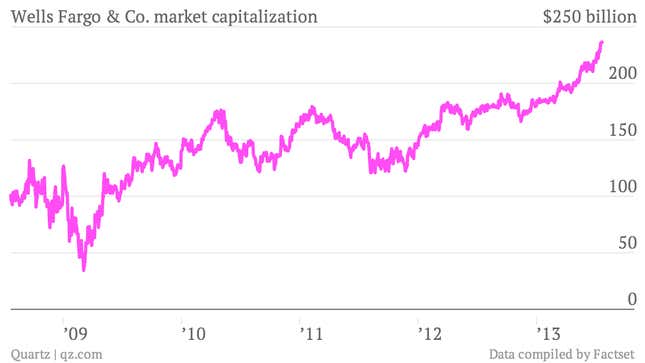Wells Fargo has stolen the title (paywall) of world’s largest bank by market capitalization from the Industrial & Commercial Bank of China (ICBC). Wells now wields a market capitalization of $236 billion. But the bank’s gains aren’t limited to size alone; the bank has emerged from the financial crisis a powerhouse, without even getting up on its soapbox.
Wells Fargo owes much of its success during the last few years to the US mortgage market, of which it controls a whopping 28%. With US home prices hitting highs since before the financial crisis, the bank has been on the right side of the trade. In the second quarter of 2013, it earned $2.2 billion on fees from mortgage originations alone. Critics point out that this dependence on the housing market could make Wells vulnerable, particularly with interest rates on the rise—which in turn means banks have to charge consumers more to purchase a home.
It’s also heavily dependent on its investment advisory and brokerage business—essentially, its money management for wealthy clients. Twenty percent of its revenues (pdf) come from that business, and another 12% come from managing trusts and other such investments. According to a study by Scorpio Partnership (pdf), Wells Fargo had the third-largest private bank in the world in 2012, with $1.4 trillion in assets under management.

But the bank has also spent the last few years expanding other parts of its business. Although still a small part of the bank’s total revenue (5%), fees from investment banking in the second quarter rose 52% from the first quarter and were up 85% year-over-year. The bank is actively recruiting investment bankers outside the US as well, building on the team the bank has had since it took over Wachovia in 2008. It has been slowly climbing industry rankings in this division, even as other banks reassess their devotion to investment banking.
Much of that growth has come from the bank’s current client base, suggesting Wells Fargo isn’t out to make a name for itself as a top investment banking powerhouse. It’s less interested in attracting new clients than providing a more full-service experience for existing ones. “I couldn’t care less about league tables…I’m more interested in kitchen tables and conference room tables,” CEO John Stumpf has said.
Overall, Wells Fargo’s attitude embodies some of the slow and steady banking praised by champions of tighter banking regulation, despite its size. Its strength in wealth management and mortgages essentially reflect demand in the US economy; Wells has a vested interest in seeing the economy do well and grow sustainably. Even the fact that Wells Fargo is based in San Francisco has moved some of its trading operations to Charlotte suggests that it’s purposely trying to distance itself from the other big investment banks on Wall Street.
Surprising, however, Wells has shied away from the spotlight, at least compared to its peers. Public arguments against increased regulation in the US have been led by JP Morgan’s Jamie Dimon, with the close support of Citigroup and Bank of America. Wells Fargo says it has been very much part of industry discussions about tighter rules for banks and has ramped up its public presence since 2008, but describes its style of interacting with the public as more understated than its peers.
And if it’s making money, its shareholders could probably care less if Wells Fargo analysts and guests aren’t frequent guests on CNBC.
An earlier version of this post inaccurately said that Wells Fargo was based in and ran trading operations out of Charlotte, North Carolina. That has been amended to reflect that Wells Fargo is based in San Francisco and runs some, but not all, of its trading operations out of Charlotte.
